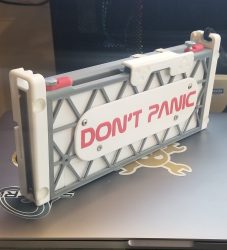If you’re looking for a long journey into the wonderful world of instrument hacking, [Arty Farty Guitars] is six parts into a seven part series on hacking an existing guitar into a guitar-hurdy-gurdy-hybrid, and it is “a trip” as the youths once said. The first video is embedded below.
The Hurdy-Gurdy is a wheeled instrument from medieval europe, which you may have heard of, given the existence of the laser-cut nerdy-gurdy, the electronic midi-gurdy we covered here, and the digi-gurdy which seems to be a hybrid of the two. In case you haven’t seen one before, the general format is for a hurdy-gurdy is this : a wheel rubs against the strings, causing them to vibrate via sliding friction, providing a sound not entirely unlike an upset violin. A keyboard on the neck of the instrument provides both fretting and press the strings onto the wheel to create sound.
[Arty Farty Guitars] is a guitar guy, so he didn’t like the part with about the keyboard. He wanted to have a Hurdy Gurdy with a guitar fretboard. It turns out that that is a lot easier said than done, even when starting with an existing guitar instead of from scratch, and [Arty Farty Guitar] takes us through all of the challenges, failures and injuries incurred along the way.
Probably the most interesting piece of the puzzle is the the cranking/keying assembly that allows one hand to control cranking the wheel AND act as keyboard for pressing strings into the wheel. It’s key to the whole build, as combining those functions on the lower hand leaves the other hand free to use the guitar fretboard half of the instrument. That controller gets its day in video five of the series. It might inspire some to start thinking about chorded computer inputs– scrolling and typing?
If you watch up to the sixth video, you learn that that the guitar’s fretting action is ultimately incompatible with pressing strings against the wheel at the precise, constant tension needed for good sound. To salvage the project he had to switch from a bowing action with a TPU-surfaced wheel to a sort of plectrum wheel, creating an instrument similar to the thousand-pick guitar we saw last year.
Even though [Arty Farty Guitars] isn’t sure this hybrid instrument can really be called a Hurdy Gurdy anymore, now that it isn’t using a bowing action, we can’t help but admire the hacking spirit that set him on this journey. We look forward to the promised concert in the upcoming 7th video, once he figures out how to play this thing nicely.
Know of any other hacked-together instruments that possibly should not exist? We’re always listening for tips.









 Peek behind the polished face and you’ll find a mechanical sleight of hand. This isn’t your grandfather’s gear-laden
Peek behind the polished face and you’ll find a mechanical sleight of hand. This isn’t your grandfather’s gear-laden 









